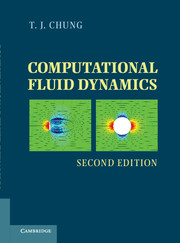Book contents
- Frontmatter
- Contents
- Preface to the First Edition
- Preface to the Revised Second Edition
- Part One Preliminaries
- Part Two Finite Difference Methods
- Part Three Finite Element Methods
- Chapter Eight Introduction to Finite Element Methods
- Chapter Nine Finite Element Interpolation Functions
- Chapter Ten Linear Problems
- Chapter Eleven Nonlinear Problems/Convection-Dominated Flows
- Chapter Twelve Incompressible Viscous Flows via Finite Element Methods
- Chapter Thirteen Compressible Flows via Finite Element Methods
- Chapter Fourteen Miscellaneous Weighted Residual Methods
- Chapter Fifteen Finite Volume Methods via Finite Element Methods
- Chapter Sixteen Relationships Between Finite Differences and Finite Elements and Other Methods
- Part Four Automatic Grid Generation, Adaptive Methods, and Computing Techniques
- Part Five Applications
- Appendixes
- Index
- References
Chapter Fourteen - Miscellaneous Weighted Residual Methods
from Part Three - Finite Element Methods
Published online by Cambridge University Press: 05 June 2012
- Frontmatter
- Contents
- Preface to the First Edition
- Preface to the Revised Second Edition
- Part One Preliminaries
- Part Two Finite Difference Methods
- Part Three Finite Element Methods
- Chapter Eight Introduction to Finite Element Methods
- Chapter Nine Finite Element Interpolation Functions
- Chapter Ten Linear Problems
- Chapter Eleven Nonlinear Problems/Convection-Dominated Flows
- Chapter Twelve Incompressible Viscous Flows via Finite Element Methods
- Chapter Thirteen Compressible Flows via Finite Element Methods
- Chapter Fourteen Miscellaneous Weighted Residual Methods
- Chapter Fifteen Finite Volume Methods via Finite Element Methods
- Chapter Sixteen Relationships Between Finite Differences and Finite Elements and Other Methods
- Part Four Automatic Grid Generation, Adaptive Methods, and Computing Techniques
- Part Five Applications
- Appendixes
- Index
- References
Summary
In the previous chapters, with an exception of GPG, the finite element formulations are based on the Galerkin methods in which test functions are chosen to be the same as the trial functions. This is not required in the weighted residual methods.
Weighted residual methods other than the Galerkin methods include spectral element methods (SEM), least square methods (LSM), moment methods, or collocation methods, in which the test functions or weighting functions are not necessarily the same as the trial functions. In spectral element methods (SEM), polynomials in terms of nodal values of the variables are combined with special functions such as Chebyshev or Legendre polynomials. For least square methods, the test functions are constructed by the derivative of the residual with respect to the nodal values of the variables. Some arbitrary functions are chosen as test functions for the moment and collocation methods. Recently, the weighted residual concept has been used in meshless configurations, known as the finite point method (FPM), partition of unity method, meshless cloud method, or element-free method.
- Type
- Chapter
- Information
- Computational Fluid Dynamics , pp. 472 - 500Publisher: Cambridge University PressPrint publication year: 2010



